Often known as the joy of plants, the viburnum, Viburnum spp, belongs to the 150-strong plant, shrub, and decorative tree family. Since the plant's beautiful and scented flowers often cause the branches to bend under their weight, the plant is named after the Latin word 'viere,' which means to bend/weave.
Read on to learn how to grow and care for viburnum plants in your garden.
More...
Viburnum Plant Details

The plant is commonly found in subtropical and temperate climates, usually in the northern hemisphere. Some species are commonly grown in other environments as well. Viburnum can grow to a height of 2 meters.
As an addition to your garden, the plant's densely green leaves interspersed with magenta and white buds are a perfect choice. During winters, viburnum flowers are a pale pink or white shade and fuse the air with a light, talcum-y fragrance.
The dark berries of the viburnum are the perfect adornment for your bushes, and the plant is only without flower and fruit for a very short while.
With viburnum, you don’t have to fight the urge to eat the small, brightly-coloured berries, because they are entirely safe for consumption. To find out more about eating and cooking with Viburnum.
Popular Viburnum Species
Sweet Viburnum (Viburnum odoratissimum)
V. odoratissimum is an iconic hedging plant, grown throughout Australia thanks to its highly scented blossom, and its ability to regenerate from old wood. This makes it perfect for hedging and easy to form into neat rows.
Despite its popularity as a hedging plant, V. odoratissimum grows naturally as a compact tree, reaching around 2m tall after 5-10 years with beautiful bark and waxy evergreen foliage.
Laurustinus (Viburnum tinus)
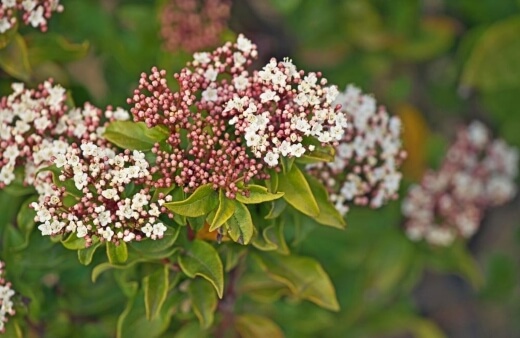
Tired of having a dreary garden every winter? V. tinus hedge plant, known by its Latin name of Laurustinus, blooms beautifully during the winter months.
With clusters of stunning white blooms that range from pink buds in mid-December to spring, with dark green foliage contrasting the flowers, the V. tinus is an instant beautifier of your garden space. Its hedging also features blue-black fruits that are appealing to foraging birds.
Learn more about this variety in our in-depth Viburnum tinus growing guide.
European Cranberry Bush (Viburnum opulus)
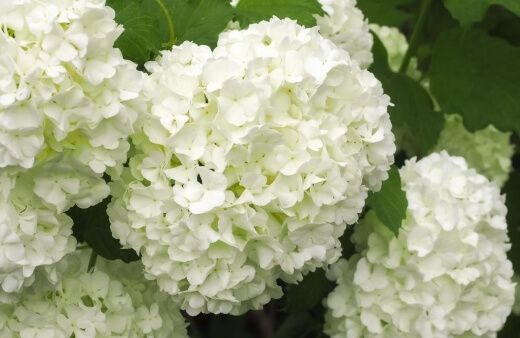
V. opulus, sometimes known as European cranberry bush, is a highbush cranberry native to Europe, Asia, and North Africa. It is a deciduous shrub with a rounded spreading habit that can reach a height of 10-15 feet.
It has small lace-cap shaped white flowers, and wide cymes of minuscule florets that are surrounded by larger ones. The three-lobed, dark green leaves in contrast to the florets make a visually appealing combination.
The red berries of the plant resemble cranberries, and are edible, but very bitter in taste. During autumn, the foliage sometimes changes from bright green to a reddish hue.
Japanese Snowball (Viburnum plicatum)
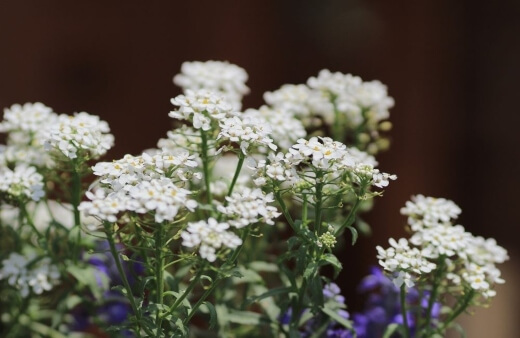
V. plicatum is an Asian shrub that may grow to be 10 feet tall, and 10 feet wide at the same time! The plant has white flowers, and the black fruit attracts pretty foraging birds to your garden space.
If you are worried about your plants losing colour in the winter, the V. plicatum mitigates that worry through its beautiful crimson and purple hues in fall. The plant can thrive in nearly all conditions, from full sun to shade, and also all variations of soil.
Koreanspice Viburnum (Viburnum carlesii)
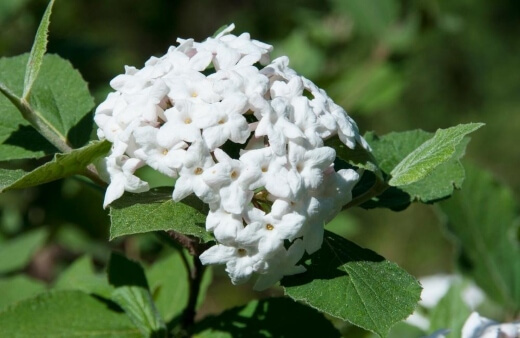
The fragrant Korean Viburnum thrives in a range of environmental conditions from full sun to moderate shade and all kinds of well-drained soils. The plant has strong, straight branches and the flowers are vibrant and fragrant.
Since the Korean Viburnum blooms on old wood, you should only prune the plant right after the blooming season is over. The plant can be grown in many ways, ranging from as a hedge, as borders for shrubs, or as a foundation plant.
Flowers with a strong fragrance develop in the middle to late spring, and noticeably fill your garden with their scent. The plant doesn't lose colour and dull out during fall, instead adopting a beautiful reddish-burgundy shade.
David Viburnum (Viburnum davidii)
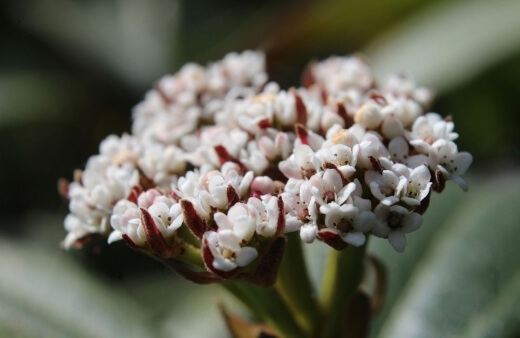
V. davidii blooms in May with bunches of white flowers and is very easy to cultivate. The plant grows very quickly when young, but slows down with age and can be pruned beautifully per your wishes.
The plant likes bright sun, but can thrive in partial, even full shade. However, for you to enjoy the full bloom of its many flowers, you should grow it in areas with brighter sunlight.
A range of environmental conditions can keep the viburnum happy, from alkaline soils to slightly acidic It is not appropriate for use as a formal, neatly cut hedge, but it does produce a lovely informal border with bright colours during fall and winter.
How to Grow Viburnum in Australia

Growing Viburnum from Seeds
Growing viburnum from seeds is a labor-intensive process, so you should instead look to propagate. However, if you want to use seeds, use warm stratification for at least two months on the seeds.
This involves keeping some environmental factors to imitate summer, like keeping the seeds with wet sand at 26 to 29°C in a sealed container or bag. Next, you should use cold stratification by keeping the sealed container in a refrigerator for a couple of months.
Use seedling trays in either a cold frame or an outdoor climate appropriate for the plant. The seeds may not germinate if there's a slight issue with any factors, so make sure you know the specifications for the type of seed you have.
Transfer the seedlings to a pot around, and only plant the seedlings into the soil in late springtime.
Propagating Viburnum
Viburnum propagation is the easier way to grow it where you want. You can use both softwood and hardwood cuttings. You can also layer branches during autumn and use the new plant to grow the type you want.
How to Care for Viburnum

Fertilisation
While it isn't among the plants that need a lot of fertilisation to get by, sporadic fertilisation makes it grow well. If your plant is in the ground, you need to follow a different fertilisation procedure than if your plant is in a container.
The best time to fertilise your plant is right after they bloom, to keep them looking sprightly and ensure healthy growth. Use tree food, organic food, and a slow-release fertiliser.
Here is our complete Australian garden fertilisers guide to help you choose the right fertiliser for this plant.
Make sure that the fertilisation is done well in advance of wintertime since lower temperatures can ruin fertilisation. In varieties that are well-suited to the type of viburnum you have, water-soluble plant food is a good option for potted plants.
Slow-release granular fertiliser or any other semi-solid liquid plant food can give your plant the extra boost it needs to grow into a robust and healthy plant.
The amount of fertiliser depends on many factors, such as the height and width your plant type is likely to grow into. Make sure when you are purchasing seeds for your viburnum, you also ask the seller to clarify the kind of fertiliser you should give them.
Understanding the structure of the this plant is essential to maintaining that you aren’t over-feeding your plant and thus, in turn, killing it.
Some species grow roots around 18-20 inches below the ground, and only the first ten or so inches are responsible for absorbing nutrients.
Therefore, some fertiliser on the surface area of the base of the roots is enough. Make sure each shrub gets an even distribution of fertiliser, 11-12 inches away from the base of the trunk and drip line.
Optimum Soil Conditions
On the pH scale, viburnum thrives best in moderately acidic conditions to slightly alkaline levels, ranging from 5.5-8. It is essential here, too, to create soil acidity per the requirements of the specific Viburnum species you are using.
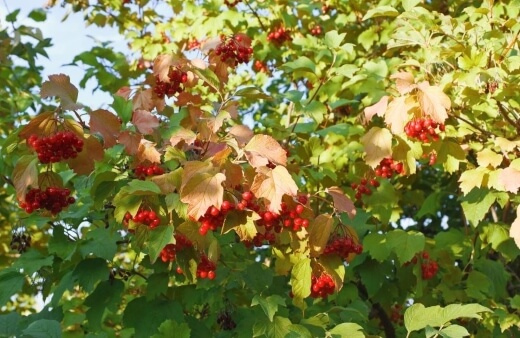
Watering Viburnums
This plant prefers water, but not to the extent that the plant is waterlogged. Mushy, soggy, or turgid soil conditions cause the plant to sicken and become more vulnerable to bacteria-borne diseases.
Well-drained soil is sufficient for all species of viburnum to be adequately hydrated. Different species have different levels of tolerance towards drought and waterlogging.
Giving a different species the incorrect amount of water can result in root rot, pests, and your plant sickening and dying. You should also frequently check soil moisture levels to ensure your plant gets only as much water as it needs.
The perfect water quantity mixed with a growth simulator at the planting time ensures a healthy, vibrant growth for your viburnum. As soon as you have sowed the seeds or propagated the shaving, soak the planting area/container liberally with a water-growth simulator mixture.
Since viburnum as a seedling plant is very susceptible to root shock and decay, a growth simulator mixed with water may give it an extra edge of strength.
Watering Viburnum at Later Stages
A young plant needs precise, required amounts of water to give you the kind of blooming shrubbery you are envisioning. The sure-fire way to kill a young viburnum plant is by watering it every day.
Waterlogged soil causes many issues like root decay that a young plant is not equipped to fight. If you live in areas of Australia that have summer rain, you needn't bother watering your Viburnum frequently.
However, keep the root area and surrounding soil between damp-moist during dry spells and droughts. Many people presume that splashing plants with water is the correct way to water them.
Instead, opt for deep-soaking the soil infrequently, letting it dry, and then watering the plant again balances the water quantities out perfectly.
Since most viburnum shrubs bloom best when planted during fall-winter, evaporation is slower, and they need less water. Assuming that the dry leaves and bugs represent a dry plant is a grave mistake.

When and How to Prune Viburnum
Pruning viburnum encourages a well-branched shrub with denser growth. Light pruning can be done at any time during the growth season, but heavy pruning should be done in late winter or early spring if necessary.
It is critical not to prune too late in the year because then you can kiss a pleasant-smelling, heavy bloom goodbye until next year.
Light pruning can be done soon after the blooming season is over, and you are noticing some decaying leaves and growth weighing down the plant’s branches.
When feeling compelled to eat the berries during the pruning period, remember that you must leave the blossom heads intact. Maintenance pruning and sucker removal can be done at any time of year.
Pruning to narrow out overgrowth should be done between February and right before flowering. Heavy pruning is best done in March or early April to allow new shoots to develop.
Even if you prune in the wrong season, the viburnum will not be harmed. You may miss a period of bloom, but the shrub will not die as a result.
Need a new pair of secateurs? Check out our review on the best secateurs you can get online.
Common Viburnum Pests and Diseases
While viburnum is generally pest-free, it can be susceptible to pests and diseases if certain environmental conditions are compromised.
- Powdery mildew can appear on leaves, but do not spray with sulfur-based sprays as this may cause harm to the foliage. There can be only some things causing your plant’s disease, and cutting those out will make the plant recover quickly- overwatering.
Avoid over watering when not needed, use a fungicide if the disease is severe, and discard any damaged leaf material. Make sure to routinely check the level of moisture in the soil and use a drainable pot to store the plant. - Botryosphaeria canker is a devastating disease that affects many ornamental plants, including the viburnum. It is distinguished by dead or wilted leaves.
There is no cure for viburnum infection, but on the occasion that the plant fights off the canker, it can typically tolerate the fungal attack many more times.
Viburnum Frequently Asked Questions
Where is the best place to plant viburnum?
Most Viburnum species like full sun, on moist but drained soil. Key to their successful establishment is fertiliser though, so make sure your soil is rich in nutrients.
If you don’t have a soil test kit, the easiest way to assess soil health is to look at the weeds and plants already there. Bare soil is rarely good soil. Weeds are a sign that soil is good for hungry plants like viburnums.
How quickly does viburnum grow?
Viburnum takes about ten years to reach maturity but can grow up to 50 cm per year in the right condition (both upwards and laterally) making it a good plant for new gardens when you want to create a more established-looking garden quickly.
How big does viburnum grow?
V. tinus, the standard species variety, can grow up to 4jm per year, while it's more common cultivar, ‘Eve Price’ grows to about half that (1.8-2m). Some shorter types like V. davidii are ideal if you don’t want the height and will spread to about 2m, but never grow taller than 1m.
Is viburnum toxic to dogs?
There are hundreds of species of Viburnum, and not a single one is toxic in any form to any human or pet. However, it has no nutritional value, so should be avoided as large quantities of any non-food plant can cause stomach upsets.
Do viburnums spread?
Viburnums spread out laterally and vertically, but rarely self-seed in gardens without a little bit of help, making them a great and easy-to-control garden plant for low-maintenance gardens, particularly if you’re trying to establish a shrubbery quickly thanks to their loose horizontal branches which fill space well.
What is the lifespan of a viburnum?
Viburnums are long lived shrubs, typically living to 50 or more years in most settings. They are largely disease and pest free (other than ants!) so provided they are planted in the right place and don’t dry out completely they should be a permanent garden fixture.
Do viburnums lose their leaves in winter?
Some species of viburnum are evergreen but the majority are deciduous, meaning they lose their foliage completely in winter. The evergreen types are nominally evergreen as their leaves are annual, but hold on until new growth pushes them off in spring.
Does viburnum need to be cut back?
Viburnum can be left to its own natural shape for a better mature structure, but for more control of your garden, or if you plan on using viburnum as hedging plants, they can easily be cut into strict forms in spring, and again in late autumn to maintain a neat, but attractive flowering hedge.
Do you need two viburnum plants to get berries?
Viburnums are monoecious plants (they have both male and female parts in each flower), and they rarely self-pollinate for some reason. For reliable berries, it’s worth having a few different plants dotted around the garden.
Viburnum berries are an excellent winter food source for garden birds.
Can you cut viburnum back to the ground?
It is possible to cut a viburnum back to the ground, and it will regrow, but there are very, very few circumstances where that should be necessary unless you are digging up the plant to move it (the harsh prune will reduce strain and encourage new growth in the new location) or the plant has fungal problems on its main stem.
Do viburnums like sun or shade?
Viburnums all prefer sun or part sun, but most species can cope with partial shade too, making them useful for challenging parts of the garden. The only warning when planting viburnums in shade or part shade is to make sure the moisture levels are well balanced; too wet, and they will rot; too dry and they won’t grow.
Do viburnums smell?
Viburnums have one of the best fragrances in the garden, and in late winter when they begin to flower, their vanilla fragrance can completely fill the garden. Their scent is similar to elder (Sambucus) with a hint of lemon to match the sweetness of the vanilla.
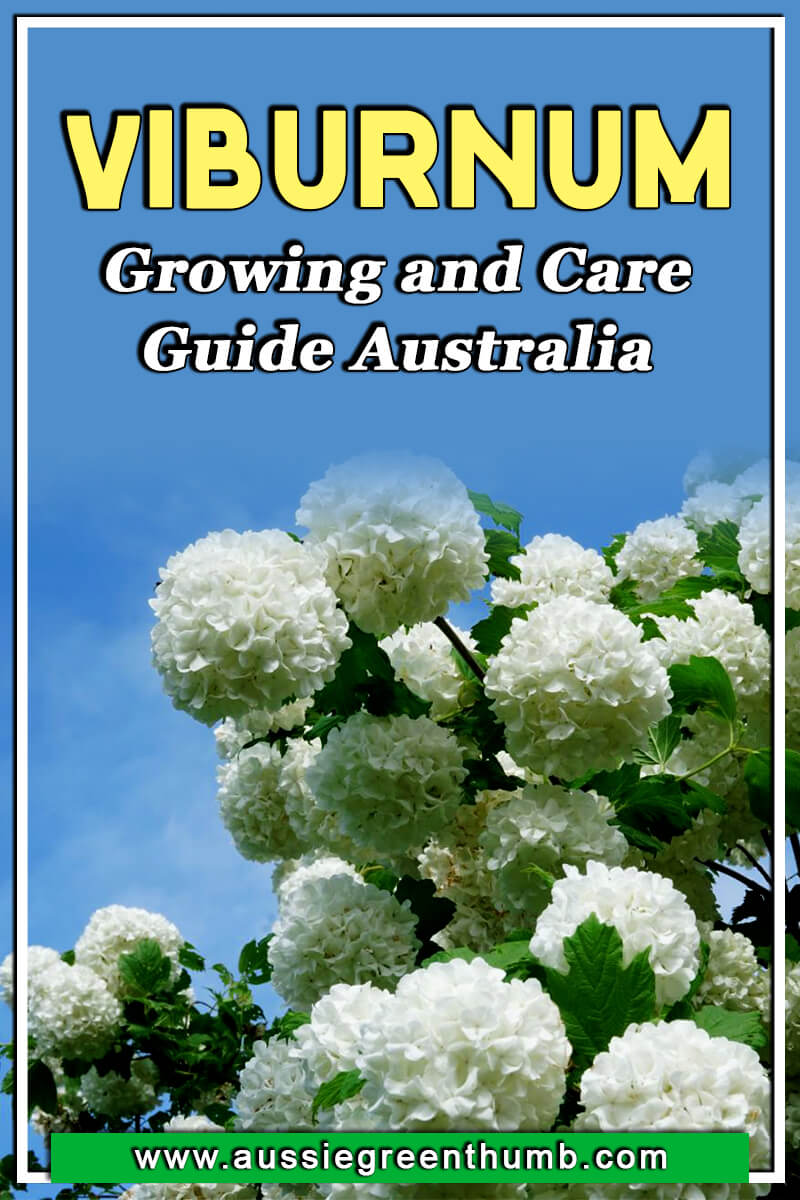
Wrapping Up Our Viburnum Growing Guide
You can pick off the flower heads and press them into books or enjoy the berries some species produce in juices, salads and drinks- the opportunities are endless!
There is no denying that the pretty foliage of viburnum will spruce up any garden space indoors or outdoors. Learning to grow and care for it is pretty simple, and viburnum doesn't disappoint in the blooming and brightening department.
Published on January 11, 2023 by Maisie Blevins
Last Updated on February 25, 2024





Hi, my viburnum tinus hedge flowers very erratically,patchy like. I’ve tipped pruned and fertilised lightly yet it’s performed the same each year. The hedges are approximately 30 mtrs long and I’d love to get it covered in flowers for winter bloom instead of patch’s here and there..any advice appreciated.
Hi there Terry,
Thanks for the question.
Many growers struggle with this same issue when trying to get their viburnums to bloom prolifically and consistently each season. There are a few factors that could be causing this issue in your plant.
The first is positioning. Your plant will flower best in a full sun position, especially in its active winter months. The more sun it gets, the more blooms it will produce.
Next is your plant’s age. Younger specimens tend to take longer to produce impressive blooms whereas mature plants will usually flower best. Your hedge sounds pretty large and established so I don’t think it’s an issue with plant age.
Tip pruning can certainly help but it is best to prune outside of your plant’s dormant months. Since viburnums bloom on old wood, pruning them before flowering will result in young bloom-producing buds being destroyed. Lightly pruning after flowering each season will encourage a wider spread of flower buds.
Another common issue could be an excess of nitrogen in your soil. This will encourage excessive vegetive growth at the cost of flower bud development. If you’re concerned, you can switch to a fertiliser with less nitrogen to see if that helps.
Performing a quick soil test is also a great way to make sure your soil is well balanced. Viburnum blooms best in well-draining, slightly acidic soils.
I hope you manage to identify how to get your viburnum to flower more prolifically. These issues highlighted are usually the cause so we’re confident that you’ll have bigger blooms in the coming seasons.
Happy gardening!
Gary Clarke